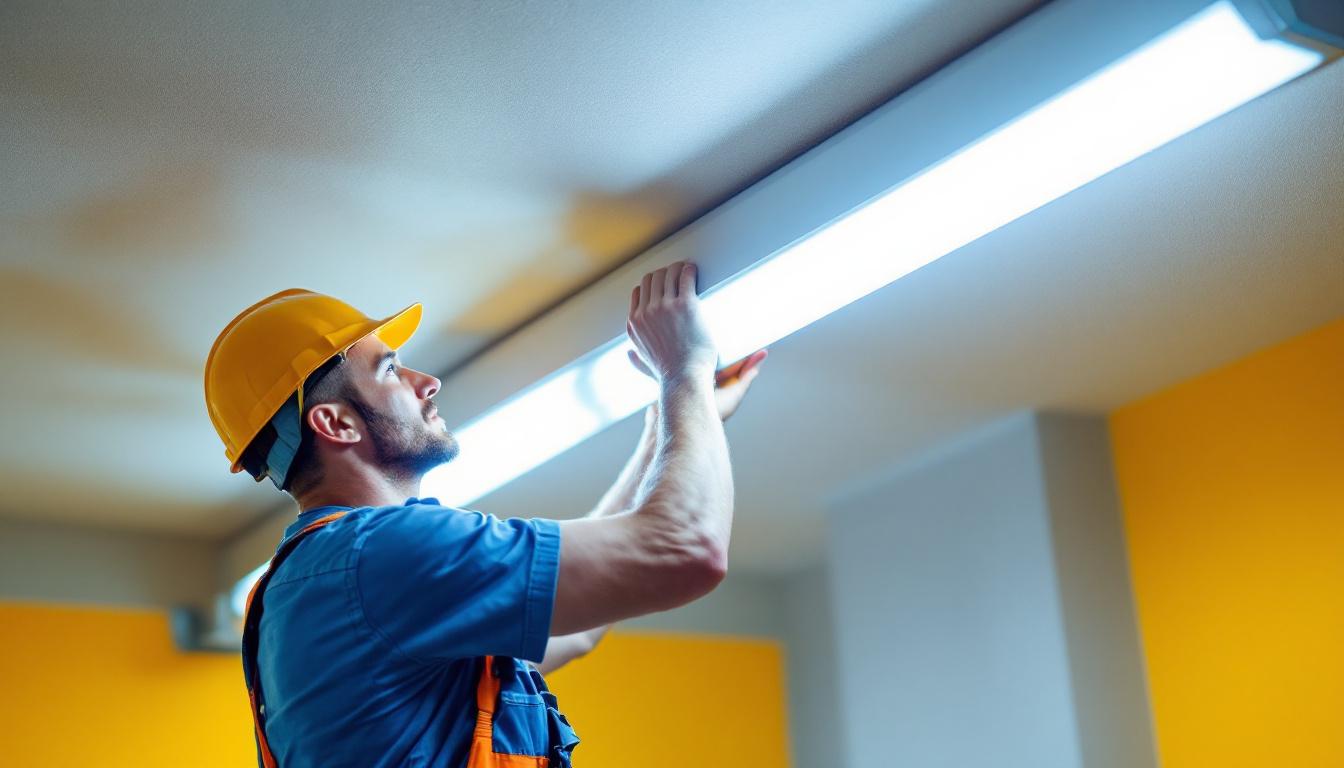
Lighting plays a pivotal role in enhancing the aesthetics and functionality of any space. For lighting contractors, the task of installing outlet lights can often come with its own set of challenges. Understanding these challenges and knowing how to navigate them is crucial for ensuring successful projects and satisfied clients. This article delves into the common obstacles faced by lighting contractors and offers practical solutions to overcome them.
One of the foremost challenges lighting contractors face is ensuring compliance with local electrical codes. These codes are designed to ensure safety and efficiency, but they can be complex and vary significantly from one jurisdiction to another. Failure to adhere to these regulations can lead to costly fines, project delays, or even safety hazards.
To navigate this challenge, contractors should familiarize themselves with the specific codes applicable to their area. Regularly attending training sessions and workshops can also keep contractors updated on any changes in regulations. Additionally, consulting with local code enforcement officials can provide clarity on ambiguous requirements. Staying informed about updates in technology and practices, such as energy-efficient lighting solutions or smart home integrations, can also help contractors anticipate changes in code that may affect their projects.
Clients often have specific visions for their lighting projects, which may not always align with practical realities. This disconnect can lead to frustration on both sides. For instance, a client may desire a particular aesthetic that requires more complex installations or higher wattage than initially anticipated.
Effective communication is key to managing these expectations. Contractors should engage clients in detailed discussions about their needs and preferences while also providing realistic assessments of what is achievable within their budget and the existing infrastructure. Providing visual aids, such as mood boards or design software simulations, can help bridge the gap between expectation and reality. Furthermore, sharing case studies of previous projects can illustrate potential challenges and successes, helping clients understand the scope of what they are asking for and fostering a collaborative atmosphere throughout the project.
Technical issues can arise during the installation process, from faulty wiring to incompatible fixtures. These problems can cause delays and increase project costs, leading to dissatisfaction among clients. Identifying potential technical difficulties before they arise is essential for a smooth installation process.
Contractors should conduct thorough site assessments prior to beginning any project. This includes checking existing wiring, assessing the condition of electrical panels, and ensuring that all components are compatible. Having a contingency plan in place can also help mitigate the impact of unforeseen technical challenges. Additionally, investing in quality tools and equipment can reduce the likelihood of technical issues, as well as improve overall efficiency during installation. Keeping an open line of communication with suppliers can also ensure that any necessary parts or replacements are readily available, minimizing downtime and keeping the project on schedule.
In the ever-evolving field of lighting, continuous education is paramount. New technologies, techniques, and regulations emerge regularly, making it essential for contractors to stay informed. Investing in ongoing training not only enhances skills but also builds credibility with clients.
Contractors can benefit from attending industry conferences, participating in online courses, and seeking certifications in specialized areas of lighting design and installation. By staying ahead of the curve, contractors can offer innovative solutions that set them apart from competitors. Additionally, joining professional organizations can provide access to valuable resources, networking opportunities, and the latest industry research. Engaging with peers and experts in the field can also inspire fresh ideas and approaches, further enriching a contractor’s skill set and knowledge base.
Establishing strong relationships with clients can significantly ease the challenges faced during projects. A trusting relationship fosters open communication, making it easier to address concerns and adjust plans as needed. Clients who feel valued are more likely to be flexible and understanding when issues arise.
To build these relationships, contractors should prioritize transparency throughout the project. Regular updates and check-ins can help clients feel involved and informed. Additionally, soliciting feedback during and after the project can demonstrate a commitment to customer satisfaction and continuous improvement. Beyond communication, personal touches—such as remembering important dates or preferences—can further strengthen the bond with clients. These small gestures can turn a one-time project into a long-lasting partnership, leading to repeat business and referrals.
Technology can be a powerful ally for lighting contractors. From project management software to advanced lighting design tools, leveraging technology can streamline processes and enhance the quality of work. For instance, using 3D modeling software allows contractors to visualize the final outcome, making it easier to communicate ideas to clients.
Moreover, employing mobile apps for on-site project management can help contractors keep track of timelines, budgets, and tasks. These tools not only improve efficiency but also contribute to a more organized workflow, reducing the likelihood of errors and miscommunication. Furthermore, utilizing data analytics can provide insights into project performance and client preferences, allowing contractors to make informed decisions and tailor their services accordingly. As technology continues to advance, staying adaptable and open to new tools will be crucial for maintaining a competitive edge in the lighting industry.
Safety is a critical concern in any electrical work, and lighting contractors must adhere to strict safety protocols to protect themselves and their clients. This includes wearing appropriate personal protective equipment (PPE) and ensuring that all tools and equipment are in good working condition.
Contractors should also conduct safety briefings before starting any project. Discussing potential hazards and outlining safety procedures can help create a culture of safety on the job site. Regularly reviewing safety practices and encouraging team members to voice concerns can further enhance safety awareness. Additionally, implementing a buddy system can foster accountability among workers, ensuring that they look out for one another and adhere to safety measures throughout the project. This collaborative approach not only boosts morale but also reinforces the importance of vigilance in maintaining a safe working environment.
In addition to following safety protocols, being prepared for emergencies is essential. Electrical work inherently carries risks, and having a plan in place can mitigate the impact of accidents or unexpected incidents. This includes knowing the location of circuit breakers, having first aid kits readily available, and ensuring that all team members are trained in emergency response.
Contractors should also establish clear communication channels for reporting emergencies. This ensures that everyone on the job site knows how to react quickly and effectively in case of an incident, ultimately safeguarding both workers and clients. Furthermore, conducting regular drills can help reinforce these emergency procedures, allowing workers to practice their responses in a controlled environment. Such preparedness not only builds confidence among the team but also ensures that they are ready to act decisively, minimizing risks and protecting lives when the unexpected occurs. Additionally, maintaining an updated contact list of emergency services and local hospitals can expedite assistance in critical situations, further enhancing overall safety on the job site.
Efficiency is key to successful project management. Streamlining workflows can help contractors complete projects on time and within budget. This can be achieved by clearly defining roles and responsibilities within the team, allowing for a more organized approach to tasks. Establishing a clear communication protocol is equally important; when team members know how to share updates and address concerns, it minimizes misunderstandings and fosters collaboration.
Using project management tools can also enhance efficiency. These tools can help track progress, manage timelines, and allocate resources effectively. By setting clear milestones and deadlines, contractors can maintain momentum throughout the project and ensure that all team members are aligned with the overall goals. Additionally, integrating automation features in these tools can reduce manual tasks, freeing up team members to focus on more strategic aspects of the project, such as innovation and quality control.
Time management is crucial in the fast-paced world of lighting contracting. Delays can lead to increased costs and dissatisfied clients. To avoid this, contractors should develop realistic timelines that account for all aspects of the project, including potential setbacks. A proactive approach, such as conducting risk assessments at the beginning of a project, can help identify possible challenges and prepare contingency plans to address them swiftly.
Implementing time-tracking tools can provide valuable insights into how time is spent on various tasks. This data can help identify areas for improvement, allowing contractors to optimize their schedules and allocate resources more effectively. Regularly reviewing timelines and adjusting as necessary can also help keep projects on track. Moreover, fostering a culture of accountability within the team encourages members to take ownership of their tasks, which can lead to increased productivity and a more engaged workforce. By prioritizing time management, contractors can not only meet deadlines but also enhance the overall quality of their work, ultimately leading to higher client satisfaction and repeat business.
Lighting contractors face a multitude of challenges when it comes to installing outlet lights, from navigating electrical codes to managing client expectations. However, by adopting proactive strategies such as continuous education, building strong client relationships, and leveraging technology, these challenges can be effectively overcome.
Moreover, prioritizing safety and enhancing project efficiency are essential components of a successful lighting contracting business. By implementing these practices, contractors can not only improve their project outcomes but also foster a reputation for reliability and excellence in the industry.
Ultimately, the key to thriving in the competitive landscape of lighting contracting lies in a commitment to quality, safety, and customer satisfaction. By embracing these principles, contractors can navigate challenges with confidence and achieve lasting success.
Ready to tackle your next lighting project with confidence? At LumenWholesale, we support your commitment to quality, safety, and customer satisfaction by providing spec-grade lighting products at unbeatable wholesale prices. Say goodbye to inflated markups and hello to a vast selection of reliable, high-performance lighting that meets the highest industry standards. With the added convenience of free shipping on bulk orders, you can ensure your projects shine without the worry of hidden fees. Elevate your lighting solutions today by visiting Wholesale Lighting at the Best Value and experience the LumenWholesale difference.

Discover the hidden techniques lighting contractors use to master halide lights.

Discover how lighting contractors can enhance their projects with 2 ft fluorescent lights.

Discover effective strategies for training your team in lighting with “Long Neck Light.” This article delves into innovative techniques and practical tips to enhance your team’s skills, ensuring they master the art of illumination for any setting.

Explore the advantages and challenges of using sconces in lighting projects.